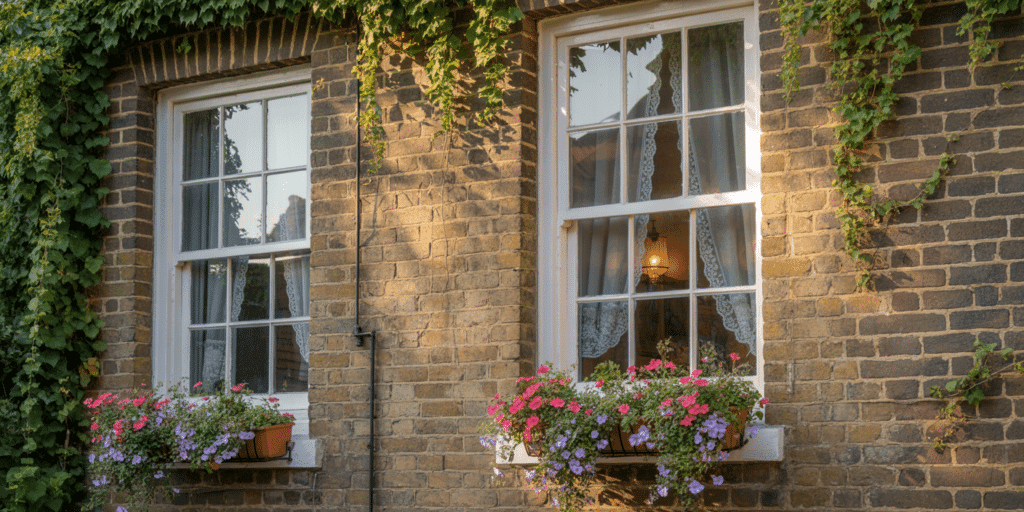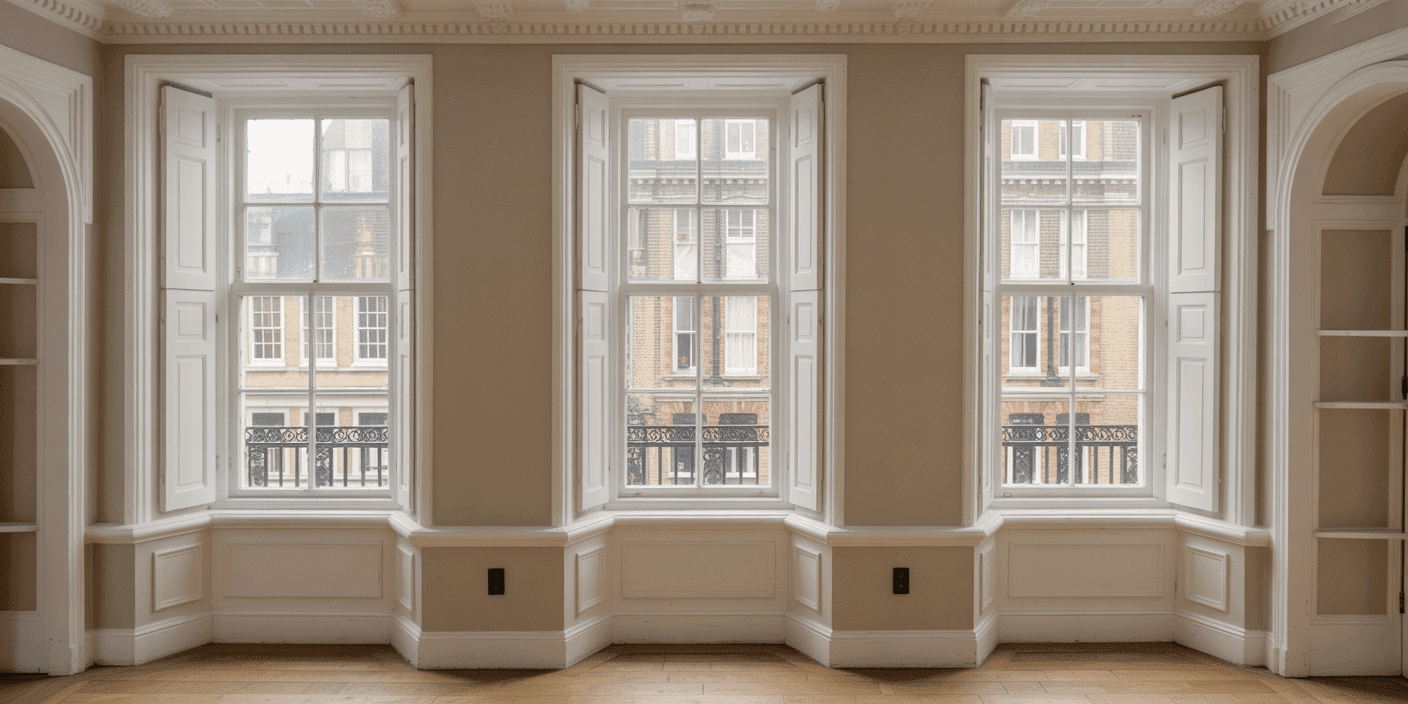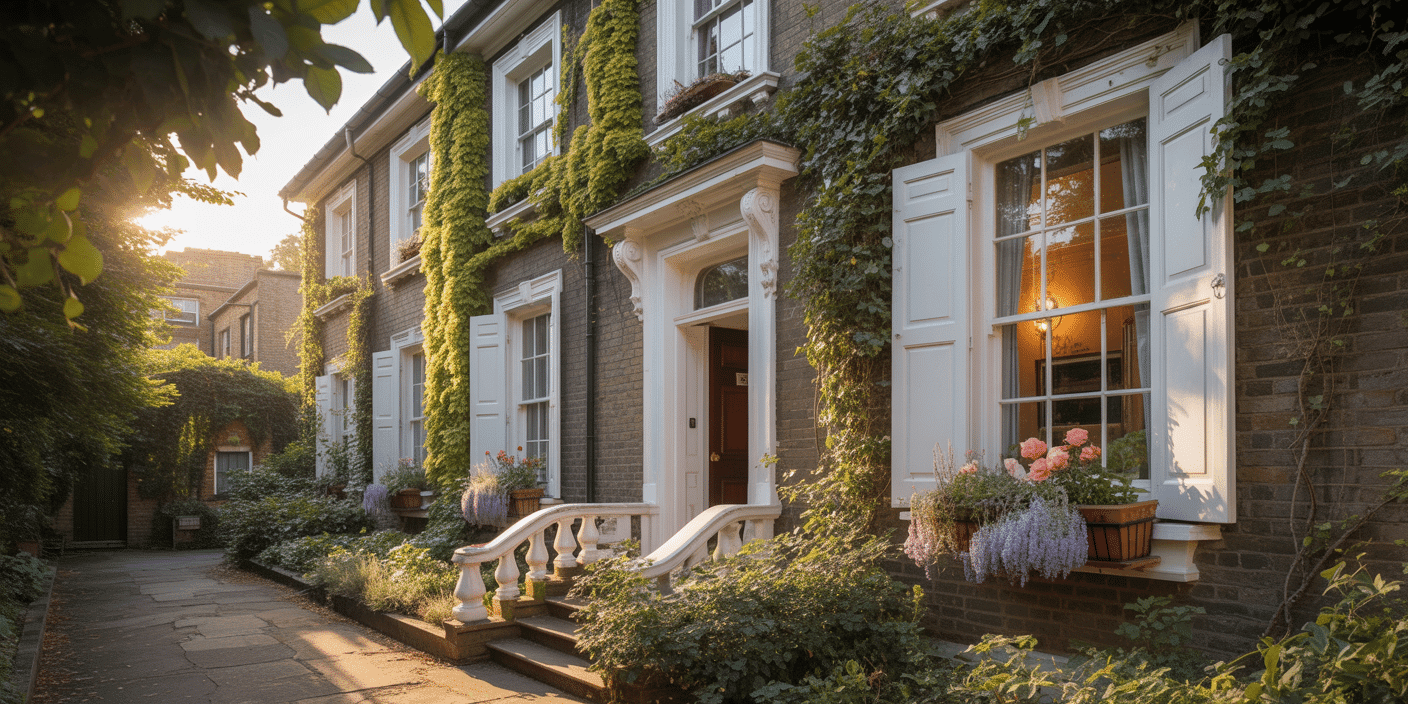The Age of Double Glazing Is Over
“Yesterday’s innovation is today’s liability.”
Once considered the gold standard of residential fenestration, double glazing is no longer fit for purpose. Developed in an era of looser regulations, lower energy costs, and modest environmental expectations, it now falls short of the demands placed on modern buildings — particularly in high-performance, high-value homes.
The issues are cumulative: thermal inefficiency, acoustic underperformance, and regulatory non-compliance. Homeowners report rising energy bills despite sealed units. Outside noise penetrates with increasing clarity. And U-values that once passed quietly through planning now trigger objections or fall short of Part L compliance altogether.
The architectural landscape has evolved. Homes are larger, more exposed, and held to stricter performance metrics — by planning authorities, energy assessors, and increasingly, the buyers themselves.
In this context, triple glazing is no longer aspirational. It is necessary.
Across conservation properties in Chelsea, detached homes in Hampstead, and restored terraces in Richmond, discerning renovators are making the switch — not for extravagance, but for certainty.
Double glazing may have defined the last chapter.
But triple glazing defines the standard going forward.
The Real Cost of Heat Loss — And Why It Starts at the Window
“Your window isn’t just a view. It’s an energy leak.”
Every homeowner knows the feeling: the heating’s on, the thermostat’s steady, yet the room still feels cold. The culprit isn’t your boiler or your walls. It’s the glass in front of you — the one thing standing between your living room and the British winter.
Up to 40% of a home’s heat escapes through its windows. That’s not a statistic; it’s a silent drain on your comfort and your wallet. Double glazing, once the gold standard, has reached its technical ceiling. Two panes can only do so much. Microscopic gaps in the seals, conductive metal spacers, and the absence of sufficient gas insulation allow warmth to slip away hour after hour.
Triple glazing changes that equation.
With three layers of glass, argon gas filling, and warm-edge spacer technology, heat loss is dramatically reduced. The U-value — the measure of how well a window prevents heat escaping — drops from around 1.6 W/m²K in typical double glazing to as low as 0.8. That difference translates to a home that stays warmer for longer, with radiators doing half the work they used to.
And when designed properly, as in the heritage-compliant frames engineered by Sash Windows London, this efficiency doesn’t come at the expense of appearance. The technology is invisible. The comfort isn’t.
In an era of soaring energy costs and tightening sustainability rules, heat retention is no longer a technical feature — it’s an economic defence.
Your windows aren’t just part of your home’s design. They’re part of its financial strategy.
Quiet Luxury: The Sound Insulation Triple Glazing Delivers

“True comfort isn’t just warm. It’s silent.”
We often speak of luxury in terms of space, finishes, or address. But in today’s world — particularly in London — luxury has a new measure: peace and quiet.
Noise is the modern intruder. Traffic rumble, barking dogs, delivery vans, aircraft overhead — even the best postcodes aren’t immune. And for many homeowners, traditional double glazing simply doesn’t keep the outside world where it belongs: outside.
This is where triple glazing proves its worth again — not with fanfare, but with stillness. The additional pane of glass and the insulating gas layers between them don’t just trap heat; they absorb sound, disperse vibration, and buffer your interior from the chaos beyond the glass.
We’re not talking about marginal gains. We’re talking about noticeable silence. In real-world terms, triple-glazed sash windows can reduce perceived noise by up to 50% compared to standard double glazing. That’s the difference between being aware of the street and forgetting it exists.
For families, it means children sleep through sirens.
For professionals, it means home offices free from distraction.
For everyone, it means a home that actually feels like a sanctuary.
And unlike many acoustic upgrades, there’s no visual penalty. Sash Windows London has perfected the art of discreet performance — acoustic lamination hidden within slimline frames, with no loss of character, and every gain in calm.
There’s a reason the world’s most coveted hotels invest in acoustic insulation: silence is value. In the domestic setting, that value is yours — every time you close the sash.
Triple Glazing and the Regulatory Wave (Part L, Q, K)
“Regulations aren’t coming. They’re already here.”
For years, energy efficiency and security were seen as optional upgrades — nice to have, but not required. That era has ended. With the rollout of tightened building regulations, particularly in England and Wales, what was once considered progressive is now legally necessary.
Let’s break it down:
📜 Part L — Conservation of Fuel and Power
This regulation sets out the minimum thermal performance standards for windows. For replacement windows in existing homes, the U-value requirement is currently 1.4 W/m²K or better — a figure that most double glazing struggles to meet without compromise.
Triple glazing, on the other hand, exceeds it easily — offering U-values as low as 0.8 W/m²K in real-world installations. This is not about over-engineering. It’s about compliance, quietly built in.
📜 Part Q — Security in New Dwellings
Security isn’t just a design preference — it’s law. Part Q mandates that all accessible doors and windows in new homes meet PAS 24 security standards.
Triple-glazed sash windows offer not only laminated glass options for additional protection, but also multi-point locking systems, timber frames reinforced for security, and the ability to discreetly meet modern safety expectations — while still maintaining the appearance of period elegance.
📜 Part K — Protection from Falling, Collision and Impact
When glass sits below 800mm from floor level, or within doors, it must be toughened or laminated to comply. Triple glazing solutions from manufacturers like Sash Windows London factor this in from the outset — using toughened glass as standard where regulations require it, without drawing attention or sacrificing aesthetics.
These rules aren’t just for architects. They’re not some niche technicality buried in planning paperwork. They are the new baseline — and failing to meet them can result in planning refusal, costly retrofits, or even insurance complications.
Triple glazing offers a fast-track through regulation.
It satisfies today’s standards and prepares for tomorrow’s, especially as future updates push toward Net Zero targets and tighter energy controls.
Those who ignore the shift will find themselves spending twice — once to install, and again to rectify.
Those who partner with a firm that understands the legislation — and designs to exceed it — will avoid the paperwork headaches and protect their property investment long term.
The ROI You Can Feel — Energy, EPC, Resale
“Triple glazing doesn’t just save heat. It stores value.”
Many homeowners still see windows as a sunk cost — an expense tied to aesthetics or basic weatherproofing. That’s outdated thinking. In the current market, upgrading to triple glazing isn’t just about insulation — it’s an intelligent investment that pays back in pounds, performance, and perception.
Let’s talk numbers.
Lower Energy Bills
Triple-glazed sash windows can reduce energy loss by up to 40% compared to older or underperforming double glazing. That translates to hundreds saved each year, especially with current and forecasted utility price volatility.
Over a 10-year period, that’s not just comfort — that’s a four-figure return in real money. And in larger, detached or period homes, the savings only grow.
Improved EPC Rating
Your Energy Performance Certificate (EPC) doesn’t just sit in a folder. It affects mortgage deals, resale potential, and buyer perception.
Triple glazing is one of the fastest ways to boost your EPC. For homes stuck at a D or lower, it could be the difference between a buyer’s hesitation and a sealed offer.
And for landlords, an EPC uplift can determine whether a property can legally remain on the rental market after 2028.
Higher Property Value & Market Desirability
Today’s buyers are increasingly savvy. They’re not just looking at the kitchen island or garden size — they’re scanning the U-values. They’re asking about bills. They want to know the home is ready for 2030, not stuck in 1995.
Triple-glazed sash windows from Sash Windows London don’t just meet those expectations — they signal them. They indicate care, foresight, and permanence — exactly what a premium buyer wants to see in a home.
In high-value areas, the difference between a quick sale and a prolonged listing often comes down to perceived effort — and thermal comfort. Triple glazing removes both doubt and draft in one silent move.
This isn’t about flashy upgrades or greenwashing.
This is about returning value to the most overlooked openings in your home — and ensuring that when the market looks through your windows, it likes what it sees.
Heritage Looks, Modern Performance — Without the Bulk

“You can have traditional charm with tomorrow’s insulation.”
There’s a lingering myth in the market — that upgrading to triple glazing means bulky, modern-looking frames that destroy the character of a period home. That might be true with mass-market products, but it is categorically false in the hands of a specialist.
Sash Windows London has spent years refining a system where performance is hidden within tradition — where every pane, profile, and putty line respects the architectural language of the building it’s part of.
Slimline Heritage Profiles
Thanks to expert joinery and advanced glass unit design, triple glazing can now be fitted into elegantly slim timber sash frames. No chunky edges. No plastic sightlines. Just refined proportions that align perfectly with Georgian, Victorian, or Edwardian styles.
These windows look indistinguishable from the originals — until you feel the warmth, the stillness, the security.
Authentic Detailing
Horned sashes, lamb’s tongue mouldings, and putty-glazed appearances are all retained. The use of Accoya or engineered hardwood ensures not only beauty, but durability — resisting warping, rot, and shrinkage for decades.
Even the hardware is faithful: period-correct ironmongery, polished brass, and durable sash cords meet modern balances and multi-point locking systems behind the scenes.
Planning-Friendly Solutions
In conservation areas or listed buildings, visual authenticity is non-negotiable. That’s why Sash Windows London regularly works with planning officers and conservation consultants to create bespoke, regulation-ready solutions that satisfy even the strictest planning frameworks.
From the pavement, no one can tell these are triple-glazed.
From inside the home, you’ll feel it immediately.
The choice used to be: keep the charm or gain the performance.
Now, thanks to the right craftsmanship, you can have both — and futureproof your home without sacrificing the very thing that made you fall in love with it.
Not All Triple Glazing Is Equal — The Artisan Difference
“The science matters. But the craftsman matters more.”
Triple glazing, for all its technical advantage, is only as good as the hands that make and install it. And in a market increasingly flooded with commoditised units and corner-cutting fabricators, this distinction matters more than ever.
Because while the phrase “triple-glazed” might appear the same in two brochures, the outcome in your home can be worlds apart.
⚠️ The Problem with Off-the-Shelf Units
Many mass-market triple-glazing products are engineered without an architectural context. Oversized, visually jarring, and poorly insulated at the frame level, they offer impressive glass specs—on paper—while failing spectacularly in real installations.
Common issues include:
- Frames too thick for heritage reveals
- Cold bridging in aluminium or PVC frames
- Inadequate gas fill or failed seals
- Non-compliance with Part Q or conservation standards
The result? A window that underperforms, looks awkward, and often needs replacing years before it should.
✅ The Sash Windows London Standard
At Sash Windows London, the process begins with design alignment. Every frame is measured, shaped, and detailed to fit both the property and the period it represents. But beyond the beauty lies serious engineering:
- Warm-edge spacers, low-emissivity coatings, and argon gas are integrated with precision.
- Glass units are manufactured to exact tolerances, ensuring consistent U-values and acoustic ratings.
- Joinery is carried out in-house or by specialist workshops using Accoya or hardwoods selected for stability and lifespan.
- Every unit is pre-approved against regulatory benchmarks, including Part L, Q, and K.
It’s not just what’s built — it’s how it’s installed.
Sash Windows London uses conservation-aware fitters, ensuring minimal disruption, full regulatory alignment, and an immaculate finish — inside and out.
🔍 True Value Lies in Execution
Two homes might both feature “triple glazing.”
But one was assembled.
The other was crafted.
When it comes to an investment as permanent and visible as your windows, shortcuts aren’t cheap — they’re expensive. And in the world of sash windows, a flawless outcome only happens when craft and compliance walk hand in hand.
Triple glazing is not a product.
It’s an architectural decision.
And it deserves the same level of thought and skill as the rest of your home.
A Warmer, Quieter, More Valuable Home — One Consultation Away
“You don’t need to compromise. You need to speak to someone who knows.”
By now, it should be clear: triple glazing is no longer a luxury — it’s the benchmark. It’s how informed homeowners protect their energy, preserve their property’s value, and prepare for the next decade of regulations and rising costs.
But choosing the right glazing partner isn’t about finding the cheapest quote or the glossiest brochure. It’s about choosing a team that understands your home’s architecture, heritage, energy profile, and resale potential — all at once.
That’s what sets Sash Windows London apart.
Here, consultation doesn’t mean a sales pitch.
It means standing in the room with a heritage-aware expert who sees the invisible:
- Where heat is escaping.
- Where noise is leaking in.
- Where future planning challenges may arise.
- And how to solve all of it without compromising the soul of your home.
Whether you live in a conservation area, a modern townhouse, or a Victorian semi, the right triple-glazed sash windows can deliver instant comfort and lasting value — quietly, elegantly, and permanently.
✅ Your Next Step:
Book your personal consultation with Sash Windows London.
We’ll assess your home, discuss your goals, and show you exactly how to turn your windows into the high-performance, regulation-ready assets they should be.
Because the right time to upgrade your windows isn’t when it’s too late.
It’s now — while you’re still in control.







